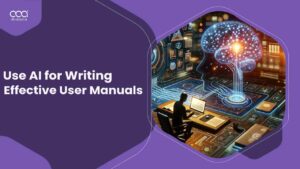When it comes to the word of theater, AI writing tools are revolutionizing how scripts are crafted, introducing new levels of creativity and efficiency. These tools are not just assistants; they are becoming integral parts of the creative process in scriptwriting.
This article goes into the nitty gritties of how to write engaging theater scripts with AI writing tools in India. I will guide you through a comprehensive step-by-step approach, uncover the enhancements that the best AI writing tools in India bring to playwriting, and discuss best practices and the future of AI in this field.
How to Write Engaging Theater Scripts with AI Writing Tools in India – Step-By-Step Guide
Crafting a theater script with AI tools requires a nuanced approach, blending technology with traditional storytelling techniques. Here’s a step by step guide on how to write engaging theatre scripts with AI writing tools.
Step 1: Define the Theme and Plot
Objective: Establish the central theme and outline the plot of your theatre script. This foundational step ensures your narrative has direction and purpose.
Practical Example:
I aimed to create a script about overcoming adversity through unity. I asked ChatGPT, “Generate a basic plot structure for a play about overcoming adversity through unity.” The AI provided a plot outline, which I used as the backbone for my script.

Step 2: Develop Characters
Objective: Create detailed character profiles to ensure each character has depth, motivation, and a distinct voice, enhancing the script’s realism and engagement.
Practical Example:
To flesh out my protagonist, I used ChatGPT, asking, “Create a detailed profile for a character who embodies unity and resilience.” The AI generated a comprehensive profile, including the character’s background, motivations, and flaws, which I integrated into the script.
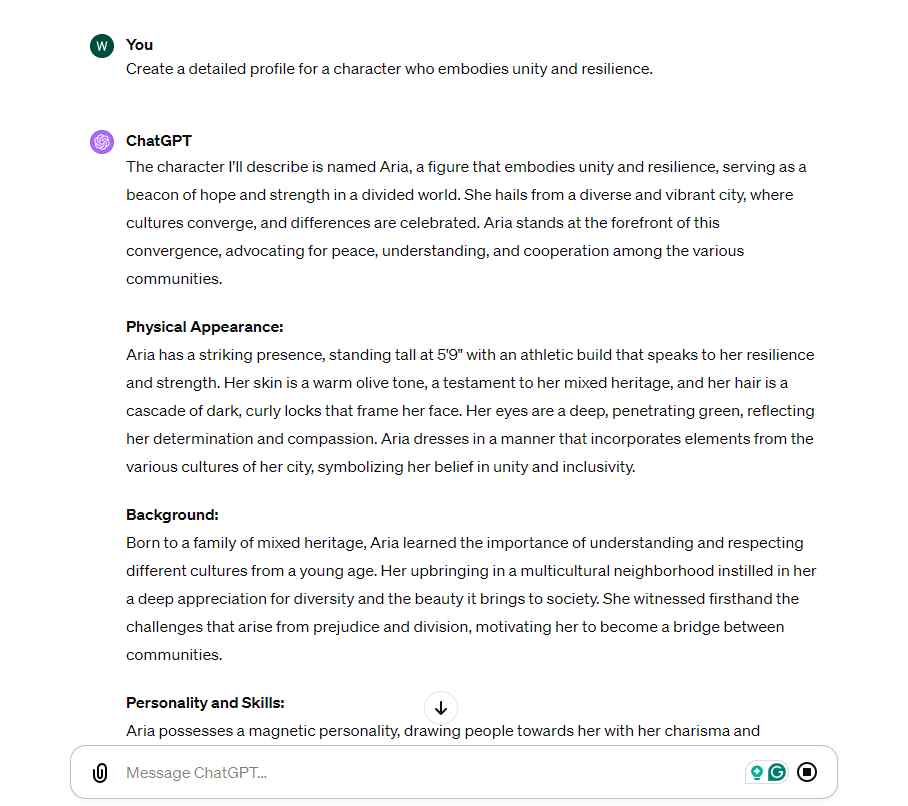
Step 3: Craft Dialogues
Objective: Utilize AI to generate dynamic dialogues that reflect each character’s personality and contribute to the story’s progression.
Practical Example:
I needed authentic dialogue for a key scene. I instructed ChatGPT, “Generate a dialogue between two characters about overcoming a challenge together in the context of unity.” The AI’s response provided a realistic and engaging exchange that I adapted for my script.
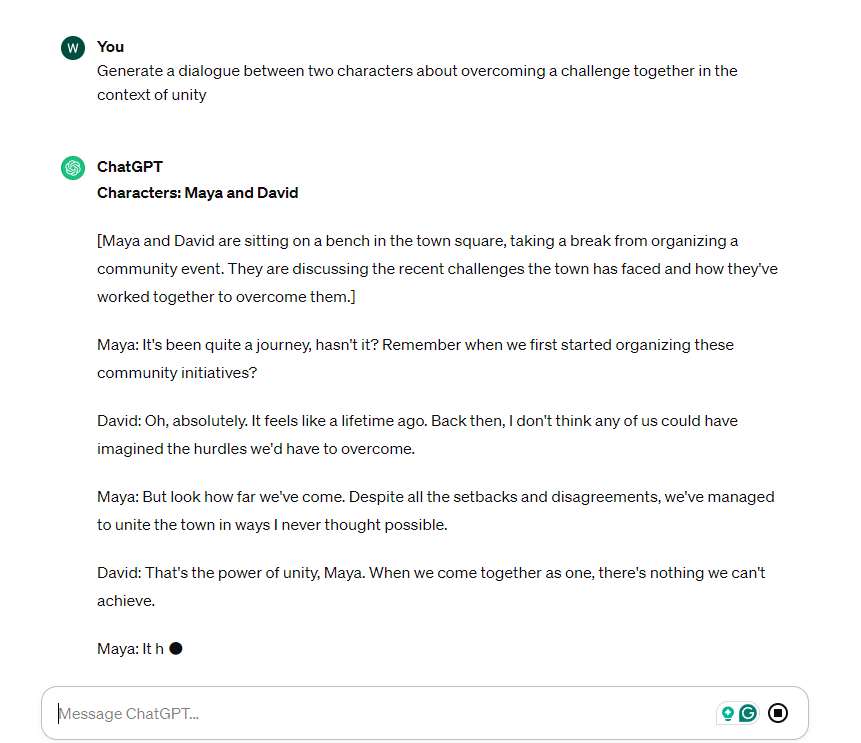
Step 4: Structure the Scenes
Objective: Organize your script into coherent scenes that build upon each other, advancing the plot and developing the characters.
Practical Example:
To structure my script effectively, I asked ChatGPT, “Outline the sequence of scenes for a play about unity overcoming adversity.” The AI suggested a scene progression that escalated the narrative tension, which I used to structure my script.

Step 5: Incorporate Stage Directions
Objective: Add detailed stage directions to guide actors and directors, ensuring the script’s vision is clearly communicated and can be effectively brought to life on stage.
Practical Example:
For a pivotal scene, I needed to convey specific actions. I asked ChatGPT, “Provide detailed stage directions for a scene where characters demonstrate unity in overcoming an obstacle.” The AI’s suggestions helped me visualize and describe the scene’s physicality, enhancing its impact.

Step 6: Edit and Refine the Script
Objective: Review and refine the script to improve its flow, clarity, and engagement. Use AI to suggest edits or alternative approaches to dialogue and scene construction.
Practical Example:
To polish my script, I consulted ChatGPT, asking, “Suggest improvements for the dialogue in the climax scene to enhance emotional impact.” The AI proposed revisions that heightened the scene’s intensity, which I incorporated into the script.
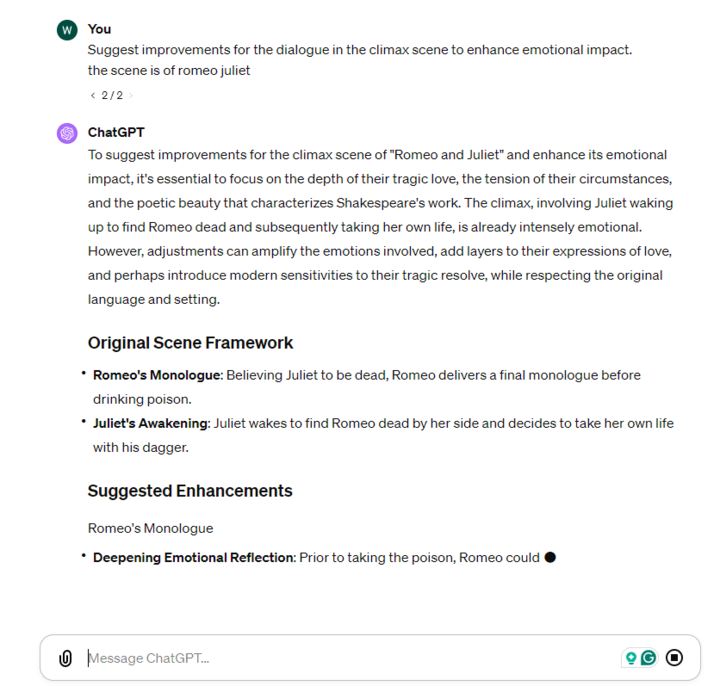
Step 7: Gather Feedback
Objective: Use AI to simulate initial audience reactions or gather feedback from peers, using insights to further refine the script.
Practical Example:
I wanted to gauge reaction to a key character’s arc. I prompted ChatGPT, “Simulate audience feedback on a character’s development from selfish to selfless.” The AI-generated feedback highlighted areas for deeper character exploration, guiding my revisions.

Step 8: Finalize the Script
Objective: Ensure the script is complete, with all elements cohesively integrated. The final script should be clear for performers and compelling for audiences.
Practical Example:
For the final review, I used ChatGPT, asking, “Conduct a final check of the script for narrative consistency and engagement.” The AI identified a few areas needing clarification, which I addressed, finalizing the script for production.

How AI Writing Tools Enhance Theater Playwriting
Now that you know how to write engaging theater scripts with AI writing tools in India, let’s talk about why you should use these tools. AI tools in theater scriptwriting offer numerous advantages. Here are a few of them.
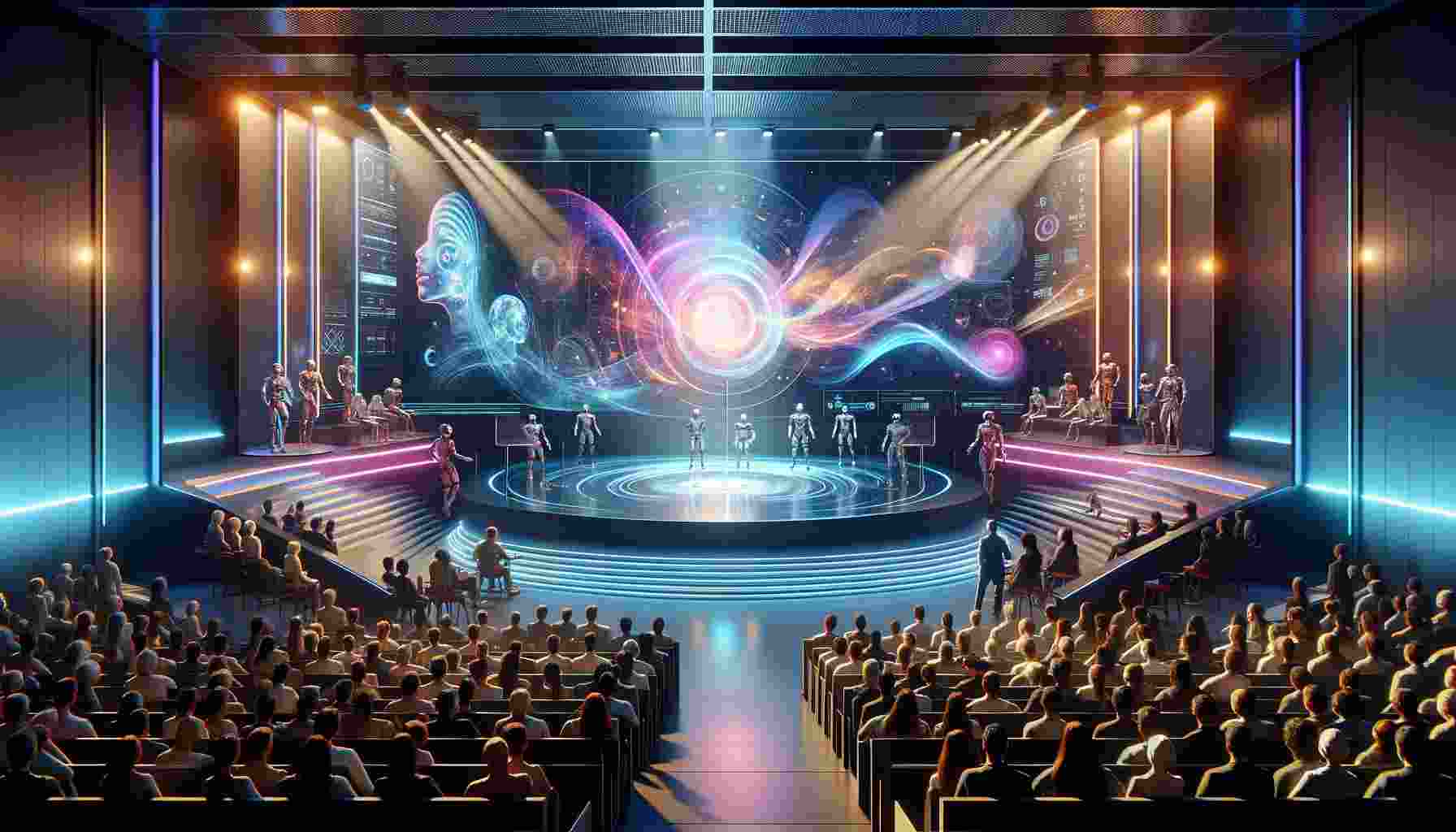
1. Expanding Creative Horizons
AI tools, like Copy.ai, can push the boundaries of traditional storytelling, offering novel ideas and perspectives that might not occur in a conventional writing process.
2. Streamlining the Writing Process
AI’s ability to quickly generate content can significantly maximize content efficiency, particularly in the initial drafting phases.
3. Deepening Character Development
Some AI tools can create complex character profiles, aiding writers in exploring their characters’ psychologies and backstories more deeply.
4. Enriching Plot Complexity
AI can suggest intricate plot lines and unexpected twists, adding depth and complexity to the narrative.
5. Diversifying Themes and Genres
AI tools have access to a vast array of themes and genres, allowing writers to explore a broader range of creative options.
6. Providing Objective Analysis
AI can offer an unbiased critique of script elements, such as pacing, structure, and character consistency.
Best Practices for Integrating AI Writing Tools for Theater Scripts
In this section, I’ll discuss eight essential best practices for effectively integrating AI writing tools in theater scriptwriting, balancing technology with the art of storytelling.
- View AI as a Collaborative Partner: Treat the AI tool as a source of inspiration and assistance, not as a substitute for your creative vision.
- Retain Artistic Control: Ensure that the final decisions and creative direction remain in your hands.
- Continuously Update Your AI Tool: As your script evolves, keep the AI tool informed with the latest information for contextually relevant suggestions.
- Use AI for Initial Drafts: Leverage AI tools mainly for brainstorming and drafting early versions of your script.
- Balance AI Suggestions with Human Insight: Weigh AI’s suggestions against your understanding of drama and storytelling.
- Ensure Emotional Authenticity: Regularly check that your script maintains the emotional depth and nuance that AI might not fully capture.
- Be Mindful of Cultural Sensitivities: Use AI tools cautiously to ensure cultural and contextual appropriateness in your script.
- Regularly Review AI-Generated Content: Continuously assess and refine AI contributions to align with your artistic goals.
What Are the Key Benefits of Using AI Tools in Theater Scriptwriting?
As we go deeper into the intersection of AI and theater scriptwriting, learning how to write engaging theater scripts with AI writing tools in India, it becomes essential to understand the key benefits these tools bring to the creative table.

From enhancing the depth of storytelling to offering new perspectives, AI tools are not just innovative but transformative in the realm of scriptwriting.
Enhancing Creativity:
AI’s natural language processing capability means it can suggest novel ideas and perspectives that broaden the creative scope of a script. It offers a plethora of ideas, themes, and narrative structures that might not be immediately apparent to a human writer, thereby enriching the storytelling process.
Saving Time:
Efficiency is a significant advantage of AI tools. Their ability to rapidly generate content allows writers to focus more on refining and embellishing the creative aspects of their scripts, rather than getting bogged down in the initial stages of idea generation and plot development.
Providing Unbiased Feedback:
One of the most valuable aspects of AI tools is their objectivity. They can offer impartial assessments of various script elements, such as pacing, structure, and character consistency, which is invaluable in the editing and refinement process.
Facilitating Richer Character Development:
AI can assist in creating detailed character profiles, allowing writers to explore their characters’ motivations, backgrounds, and arcs in greater depth. This leads to more nuanced and compelling characters in the scripts.
Expanding Narrative Possibilities:
With access to a vast array of data on themes, genres, and narrative techniques, AI can suggest diverse plot developments and thematic explorations, thereby enriching the narrative and providing fresh storytelling avenues.
What Are the Challenges in Implementing AI for Theater Scriptwriting?
There are six crucial challenges when implementing AI in theater scriptwriting, a key component of learning how to write engaging theater scripts with AI writing tools in India.
These range from maintaining emotional depth to managing audience expectations and ethical considerations, all of which are essential for leveraging technology to enhance the creative process effectively.
- Maintaining Emotional Depth: Ensuring that the script retains the human touch and emotional authenticity that AI might not fully replicate.
- Navigating Ethical Considerations: Dealing with issues of originality and authorship when using AI-generated content.
- Overcoming Technical Limitations: Addressing the limitations of AI in understanding the nuances of human emotion and cultural subtleties.
- Balancing AI and Human Input: Finding the right balance between AI suggestions and human creativity.
- Ensuring Cultural Relevance: Making sure that AI-generated content is culturally sensitive and contextually appropriate.
- Managing Audience Expectations: Dealing with audience perceptions and expectations regarding the use of AI in creative processes.
What is the Future of AI in Theater Scriptwriting?
Looking towards the future, AI’s role in theater scriptwriting is not only promising but also indicative of a significant shift in how narratives are conceived and developed.

The potential advancements in AI technology promise to further enrich the art of scriptwriting, opening doors to unexplored creative territories.
Advanced Emotional Intelligence:
Future AI tools are expected to offer more nuanced understanding and interpretation of human emotions. This development will enhance their ability to contribute to emotionally driven narratives, making AI-generated suggestions even more relevant and impactful for scriptwriting.
Greater Cultural Awareness:
The next generation of AI in scriptwriting will likely become more adept at incorporating diverse cultural contexts. This will make AI a more versatile tool for writers looking to create globally resonant and culturally sensitive content.
Seamless Human-AI Collaboration:
The integration of AI in scriptwriting is anticipated to become more fluid and intuitive. AI tools will likely evolve to become indistinguishable from the human creative process, acting as an invisible but powerful assistant in the storytelling journey.
AI as a Training Tool:
Emerging AI technologies hold the potential to serve as educational tools for aspiring playwrights. They could offer guidance, critique, and feedback, becoming a valuable resource for learning and honing scriptwriting skills.
Expansion into New Storytelling Realms:
AI might lead the way in exploring new forms of interactive and immersive theater experiences. This could redefine the boundaries of storytelling, offering audiences novel and more engaging ways to experience narratives.
FAQs
Can I use AI to write a script?
How do you write a script in artificial intelligence?
Can AI write a story?
Can GPT-4 write scripts?
Conclusion
The integration of AI writing tools in theater scriptwriting is not just a passing trend but a movement reshaping storytelling. The benefits of AI are manifold – from enhancing creative possibilities to offering objective feedback, and from saving valuable time to enriching character development.
Now that you know how to write engaging theater scripts with AI writing tools in India, don’t stop there. There’s a whole host of things AI writing tools can help you with. If you’re looking to learn more, check out the how-to guides on allaboutai. Or you can enhance your understanding of our AI terms by visiting our AI glossary.




